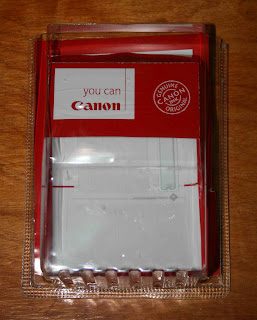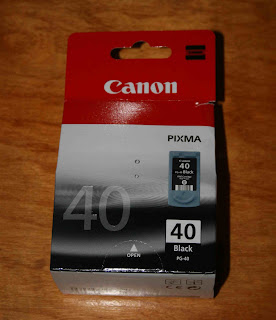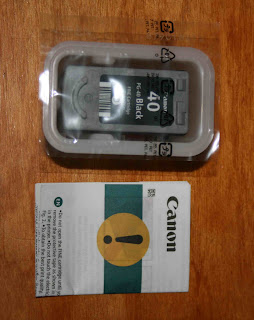There are a number of marketing concepts which capture the consumer with a proprietary and branded system that requires regular replenishment of equally proprietary and costly refills. There are two “handcuff” systems with which I am confronted on a regular basis: my Gillette Mach 3 razor and my bluetooth Canon printer. In both cases, the price of the “refill” is absolutely stunning.
Yesterday, for my Canon Pixma MP470 printer, I purchased a replacement black (PG40) and colour (PG41) ink cartridge at the local Ternes FNAC. The price for the two cartridges was 47 euros — and I certainly do not get the feeling that they are long lasting. The challenge that I have with this particular ‘system’ is the incredible amount of packaging that goes along with the cartridges… as if the amount of packaging justified the price? Below, I detail what embalms each ink cartridge.
First stop, the outer packaging. A large plastic container, with some paper inserts for on-shelf communication purposes.
Next step, a cardboard inner box, which is visible from the outside in the open space in the bottom of the outer. This packaging even comes with a slot to “hang” on a rack — proof that it can live alone.
Once you have opened up this cardboard box, you get to packaging layer #3. A plastic tub, with a film over the top, presumably to keep the ink cartridge “fresh”. In addition, you also get paper foldout multilingual instructions. And, of course, before you insert the ink cartridge, you have the final little orange plastic strip to remove (to “enable” the ink).
The scale of the waste is quite impressive merely on the micro level. However, in the US alone, according to Ink Guides, “[o]ver 375 million empty toner cartridges and ink cartridges are thrown into the trash every year in the US… [meaning] roughly 11 cartridges being disposed of every second.” In a surprising statement, in the US, apparently 30% of all ink cartridges and 50% of all toner cartridges are being recycled. I am not aware of the circuit for such recycling in France, but I would doubt that Europe reaches those still-low levels.
To this end, I believe it would be fully appropriate for Canon to provide documentation on how to recycle their ink cartridges and all the superfluous waste. There are now a growing number of opportunities and ways to recycle or even refurbish ink cartridges. Here is Cartridge Fundraising, a friendly site with advice and ways to recycle. [And herewith an interesting site for further reading on the topic: Ink Guides.]
As I mentioned at the outset of this post, the prices of these refills is quite outrageous compared to the “hardware” cost. Looking across a few e-commerce sites, the variation in pricing of these ink cartridges would lead me to speculate about how much “profit” is being drawn. The list price for the PG40 black ink cartridge is stated in the US as being $39. Amazon is currently selling them at a massive 50% discount at $18; but you can also buy “new” ones at $14 on Amazon. Incredibly, used ones are also going for $14. Refurbished cartridges are going for $13. Another option is the generic cartridge. Here is one for Canon ink cartridges: Castle Ink — where the generic version is being sold for $18.














The more than 30 patterns detailed here are easy, filled with explicit directions, photographs, and illustrations, and they are labeled with completion time, level of difficulty, materials, and software needed
You're right. I was really guided by the explanations not to mention the graphics. I must admit I'm a slow learner but this blog is really of great help.
Canons has adopted a new approach called FINE (short for Fullphotolithography Inkjet Nozzle Engineering) utilising a a different ink ejection system and nozzle.